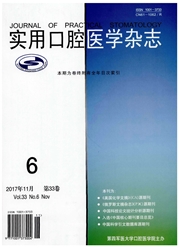

 中文摘要:
中文摘要:
目的 评价强化疼痛教育对跟骨骨折围手术期患者疼痛认知及疼痛控制效果的影响.方法 将174例跟骨骨折患者随机分为研究组和对照组,各87例,分别采用1+1式强化疼痛教育和传统综合方式进行健康教育,采用疼痛及疼痛控制认知量表进行调查,并比较两组术后疼痛控制效果和满意度.结果 研究组对疼痛控制积极性、表达意识、参与性和重视程度显著高于对照组(P<0.05).研究组对止痛药物的认知和采取止痛治疗较对照组更为积极(P<0.05).研究组术后1~3天疼痛程度均显著低于对照组(P<0.05),使用止痛药和主动疼痛表达比例均显著高于对照组(P<0.05).研究组对疼痛教育、疼痛控制、家属及陪护协助的满意度均显著高于对照组(P<0.05).结论 强化疼痛教育能有效提高患者对疼痛和止痛药物应用的认知并改善患者进行疼痛控制的积极性和主动性,疼痛控制效果明显提高,有利于患者预后恢复.
 英文摘要:
英文摘要:
Objective To evaluate pain education for pain cognitive and pain control effect of patients in perioperative with calcaneal fractures. Methods A total of 174 cases of calcaneal fractures were randomly divided into study group and control group of 87 cases respectively, in 1 +1 formula strengthen pain education and traditional integrated approach to health education, the use of pain and pain control cognitive scale investigation, and the effects of postopera- tive pain control and satisfaction were compared. Results The study group enthusiasm for pain control, expressed awareness, participation and the degree of attention were significantly higher (P 〈0.05). Study group on the cognitive and taked pain medication pain treatment more active than the control group (P 〈0.05). Study group after 1 to 3 days of pain were significantly lower than the control group (P 〈0.05), the use of painkillers and active expression of pain were significantly higher proportion (P 〈0.05). Study group education on pain, pain control, assisting families and ac- companying satisfaction were significantly higher (P 〈0.05). Conclusion Pain education could effectively improve the pa- tient's pain and analgesic drug use and improve cognition in patients with pain control enthusiasm and initiative, pain control was improved obviously, conducive to the prognosis of patients recovery.
 同期刊论文项目
同期刊论文项目
 同项目期刊论文
同项目期刊论文
 Effect of calcitonin gene-related peptide on osteoblast differentiation in an osteoblast and endothe
Effect of calcitonin gene-related peptide on osteoblast differentiation in an osteoblast and endothe Effect of calcitonin gene-related peptide on nitric oxide production in osteoblasts: an experimental
Effect of calcitonin gene-related peptide on nitric oxide production in osteoblasts: an experimental 期刊信息
期刊信息
